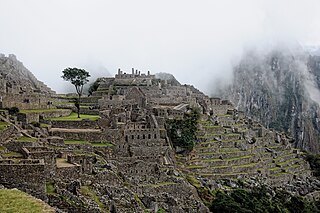
When I read not long ago that Peru‘s legendary Andean site Machu Picchu had made the top of TripAdvisor‘s annual “Traveler’s Choice” list of most prominent world landmarks, I certainly wasn’t surprised (though admittedly, the list was more than a little weird in some ways – number two was some mosque in Abu Dhabi, while the Parthenon and the Pyramid of Giza didn’t even crack the top ten).
 Be that as it may, there are of course many stunning relics of human civilization that have accumulated over the millennia – among them the many ruins of Greek and Roman antiquity; Egypt’s pyramids and tombs from the time of the pharaohs; the elaborate ancient temples in places like India and Cambodia; and of course the spectacular cities of the Mayans. But although Machu Picchu isn’t the grandest of such sites per se, the combination of its layout and structures with the breathtaking natural scenery that surrounds them is what truly blows visitors away, and pictures like the ones you see here only tell part of the story
Be that as it may, there are of course many stunning relics of human civilization that have accumulated over the millennia – among them the many ruins of Greek and Roman antiquity; Egypt’s pyramids and tombs from the time of the pharaohs; the elaborate ancient temples in places like India and Cambodia; and of course the spectacular cities of the Mayans. But although Machu Picchu isn’t the grandest of such sites per se, the combination of its layout and structures with the breathtaking natural scenery that surrounds them is what truly blows visitors away, and pictures like the ones you see here only tell part of the story
.
Another reason this incredible “lost city” of the ancient Incas, dating from the mid-15th century, has been in the news is that it’s connected via the Inca Trail (used by more adventurous visitors on foot and horseback, in treks lasting two to five days) to the Qhapaq Ñan, an Inca road system running from present-day Colombia down through northern Chile, and that system has was included in the latest round of additions to the list of UNESCO World Heritage Sites.

The site at the end of this trail that everyone makes such a fuss about is, again, relatively compact in size – the site as a whole covers 32,500 hectares (125 square miles) but the main part open to visitor exploration is a tiny fraction of that – an “urban sector” of 10 hectares and an “agricultural sector” covering 20. There are some 200 buildings of polished dry-stone walls, with temples and noble residences predominating in the upper town, warehouses and commoners’ houses in the lower town. Highlights include the Temple of the Sun; the ritual stone called the Inti Watana; and the Room of the Three Windows.
 Getting Here and Overnighting
Getting Here and Overnighting
Fortunately, as cool as hiking the Inca Trail (left) is, it’s obviously not for everyone – and even less so these days, because you have to book well in advance, through one of the various authorized tour operators. Most visitors still come the usual way, which is to say, via a two-hour PeruRail train ride from nearby Cuzco (classes of service range from backpacker to luxury, and many folks who hike the trail out take the train back), as there is no real way to get in by road.
That brings you into the small town of Aguas Calientes, aka Machu Picchu Pueblo, founded in a gorge below the ruins during the building of the railroad and today a not particularly charming but certainly convenient tourist hub with budget and midrange accommodations (along with restaurants and pubs) in town and more luxurious lodgings on the outskirts and surounding areas (such as the Inkaterra Machu Picchu Pueblo Hotel andSumaq Machu Picchu Hotel). By far the majority of visitors come and go in the same day, but there are benefits to overnighting, such as getting up to experience the ruins at sunrise and before the crowds arrive. Another reason to get here early is that visitors are currently limited to 2,500 per day.
Speaking of which, to get up the hill to the main event, you have a couple of choices. First is on foot, a climb of more than 1,600 feet (488 meters), mostly via ancient stone steps – which even if you’re young and/or fit you’ll want to make sure you’re acclimated for first, because here remember you’re 7,970 feet (2,430 metres) above sea level; while lower than Cuzco, this can still leave you subject to soroche (altitude sickness) - which, believe you me, is no fun, and if you’re exerting yourself trying to climb a mini-mountain could be a really bad idea. Anyhow, it should take you one to two hours, depending on the pace you can set, and this is where it’s a good idea to stay overnight in town, to get an early start. The second is by bus, which is how I went up both times I’ve visited. This proceeds along a series of steep switchbacks, which can be a bit unnerving if you’re a bit nervous about heights, as I am.
There’s yet another bit of dramatic news on the horizon, too. The Peruvian government has finalized a deal to build a new regional airport near the town of Chinchero, which will more than double and could eventually quadruple the number of annual visitors currently brought in via Cuzco airport when it opens in 2020. It will definitely mean challenges to manage, so that the beauty of places like Machu Picchu and other areas of the Sacred Valley can be preserved for future generations.
More information: www.Peru.travel.
images | Martin St-Amant, Rtype909, Pajaro
Comments